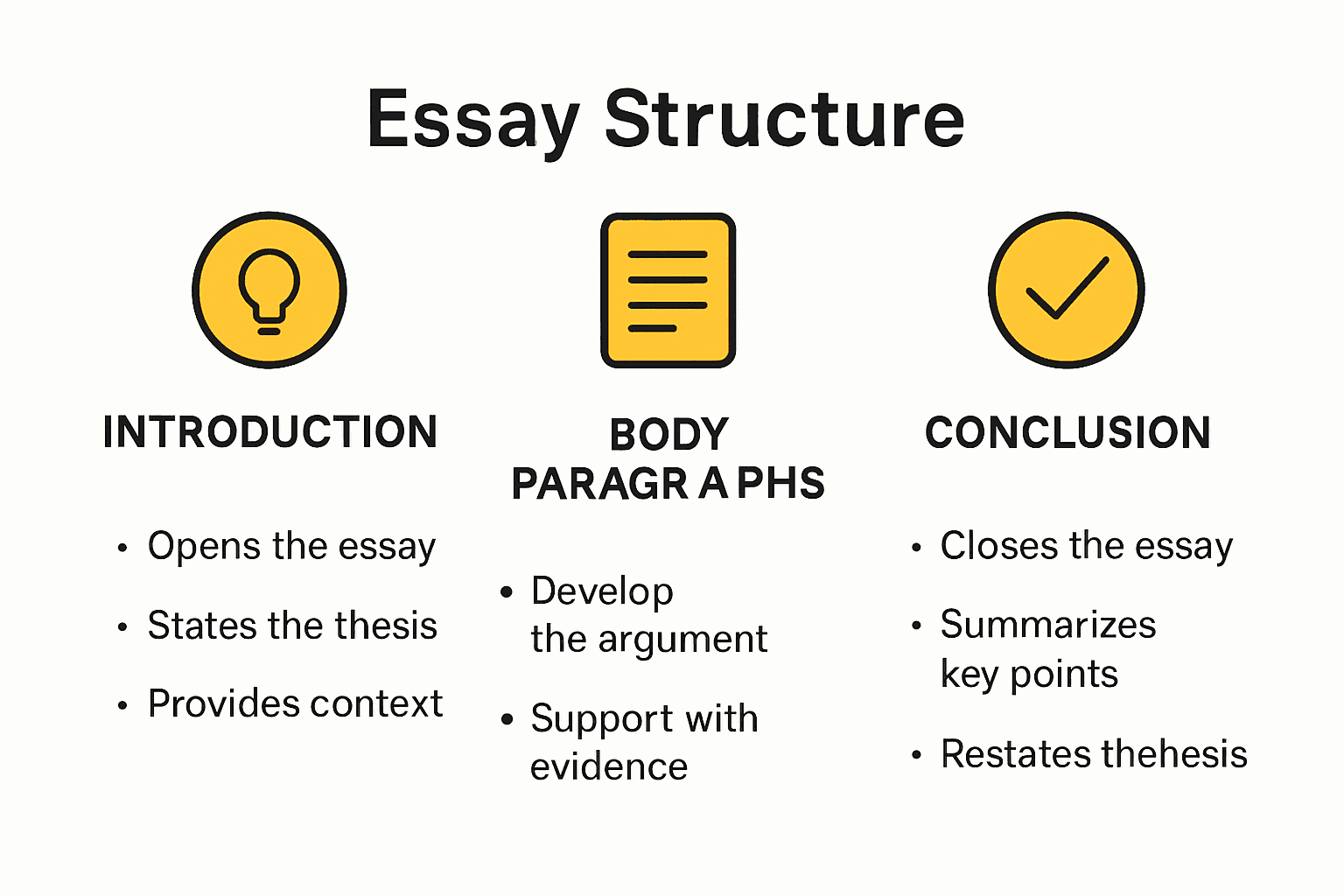Blog
Learning Materials
Standard Essay Format Guide for 2025: Structure, Tips, and Examples
Updated: June 29, 2025

Everyone knows the standard essay format starts with an introduction, stacks up body paragraphs, and ends with a conclusion. Here is a surprise. It is not the checklist of sections or even the order that makes essays stand out. The real difference is how you use structure to guide readers through your argument. Research found that rigidly sticking to a five-paragraph formula actually limits deeper analysis and leads to weaker papers. There is a smarter way to use structure so your essay feels both clear and persuasive.
Table of Contents
- The Three Core Components Of Essay Structure
- Structuring Arguments For Maximum Impact
- Maintaining Coherence And Unity
- Document Formatting And Technical Specifications
- Citation And Reference Standards
- Structural Consistency And Professional Presentation
Quick Summary
| Takeaway | Explanation |
|---|---|
| Clear Essay Structure | Every standard essay should include a structured framework of introduction, body paragraphs, and conclusion, ensuring a logical and persuasive presentation of ideas. |
| Precise Document Formatting | Adhere to specific formatting guidelines, such as font type, size, line spacing, and margins, to enhance readability and maintain a professional appearance. |
| Consistent Citation Practices | Use a single citation style consistently throughout your essay to demonstrate academic integrity and avoid plagiarism, paying close attention to in-text citations and reference lists. |
| Focused Paragraph Organization | Each paragraph should revolve around a single main idea, introduced by a clear topic sentence, supported by evidence, and concluded with a transition, ensuring coherence and logical flow. |
| Avoid Common Mistakes | Be aware of structural pitfalls, vague paragraph organization, and citation errors; review your work critically and seek feedback to enhance overall quality. |
Understanding the Standard Essay Structure
Writing an effective essay requires a clear and structured approach. The standard essay structure serves as a fundamental blueprint that guides writers in presenting their ideas logically and persuasively. Understanding this structure is crucial for creating coherent and compelling academic writing.

The Three Core Components of Essay Structure
Every standard essay follows a consistent framework composed of three essential sections: the introduction, body paragraphs, and conclusion. Explore our comprehensive guide to essay formats to gain deeper insights into these critical components.
The introduction acts as the gateway to your essay, providing readers with critical context and a clear roadmap of your argument. It typically includes three key elements: a compelling hook to capture attention, background information to establish the topic's relevance, and a concise thesis statement that outlines the central argument or perspective.
Body paragraphs form the substantive core of the essay, where writers develop and support their thesis through carefully constructed arguments. Each paragraph should focus on a single main idea that directly relates to the thesis, presenting evidence, analysis, and logical reasoning. The progression of these paragraphs is strategic - moving from more straightforward, widely accepted claims to more nuanced and complex arguments.
The conclusion serves as the final synthesis of your essay, performing several critical functions. It restates the thesis, summarizes the key arguments presented in the body paragraphs, and provides a final thought that leaves a lasting impression on the reader. Unlike the body paragraphs, the conclusion should not introduce new information but instead reinforce the essay's core message.
To help clarify the distinct structure and core elements of each essay part, the following table summarizes the purpose and key components of the introduction, body, and conclusion.
| Section | Purpose | Key Components |
|---|---|---|
| Introduction | Introduces topic, sets context, and states thesis | Hook, background info, thesis statement |
| Body Paragraph | Develops arguments in support of thesis | Topic sentence, evidence/analysis, transition |
| Conclusion | Synthesizes main points, reinforces message | Restated thesis, summary of arguments, final thought/implication |
Structuring Arguments for Maximum Impact
Effective essay writing goes beyond simply following a template. According to research from academic writing experts, the organization of arguments plays a crucial role in essay effectiveness. Writers should consider arranging body paragraphs based on the strength of arguments, logical progression, or comparative analysis.
This strategic arrangement helps readers follow the intellectual journey of the essay. By carefully building arguments from simpler to more complex ideas, writers can enhance the credibility and persuasiveness of their perspective. Each paragraph should seamlessly connect to the next, creating a fluid narrative that guides the reader through the essay's central argument.
Consider the logical flow of your ideas. Start with the most fundamental points that establish a foundation for your argument, then progressively introduce more sophisticated analysis. This approach not only improves readability but also demonstrates the depth and complexity of your thinking.
Maintaining Coherence and Unity
A well-structured essay maintains a consistent focus and coherence throughout. This means ensuring that every paragraph, every sentence, directly supports the central thesis. Transitional phrases and clear topic sentences help create smooth connections between ideas, preventing the essay from feeling disjointed or fragmented.
Remember that the standard essay format is a flexible framework, not a rigid constraint. While adhering to this structure, writers should still allow room for creativity and unique analytical approaches. The goal is to present ideas clearly, logically, and persuasively, engaging readers and effectively communicating your academic perspective.
Key Elements in the Standard Essay Format

In the academic landscape of 2025, mastering the standard essay format requires a comprehensive understanding of its key structural and technical elements. Discover our comprehensive formatting guide to ensure your essays meet contemporary academic standards.
Document Formatting and Technical Specifications
The technical foundation of a standard essay begins with precise document specifications. According to academic writing guidelines, contemporary essays require specific formatting parameters. Typically, this includes using Times New Roman font at 12-point size, maintaining 1.5 line spacing, and implementing 1-inch margins on all sides. These seemingly minor details significantly impact the essay's readability and professional appearance.
Page numbering is crucial, with most academic formats requiring consecutive numbering in the top right or bottom center of each page. The title page represents another critical element, which should include the essay title, author's name, institutional affiliation, course details, and submission date. Modern academic guidelines increasingly emphasize clean, minimalist design that prioritizes clarity and readability.
To provide a clear overview, the following table summarizes the standard formatting parameters and document elements required for academic essays in 2025.
| Formatting Element | Standard Specification / Practice |
|---|---|
| Font | Times New Roman, 12-point (sometimes size 11 permitted) |
| Line Spacing | 1.5 spacing (sometimes double spacing) |
| Margins | 1 inch on all sides |
| Page Numbers | Top right or bottom center, consecutive |
| Title Page | Title, author's name, institution, course, submission date |
| Submission Format | PDF or Word document, personal info removed for blind review where required |
Citation and Reference Standards
Citation styles form the backbone of academic integrity in essay writing. Different disciplines typically adhere to specific citation formats such as APA, MLA, or Chicago Style. Each style has unique requirements for in-text citations, reference lists, and bibliographic entries. Precision in citation is not just about avoiding plagiarism but also about demonstrating scholarly rigor and acknowledging intellectual contributions.
In 2025, digital submission formats have become standard, with PDF and Word documents being most widely accepted. Many institutions now recommend removing personal identifiers to facilitate blind review processes, further emphasizing the importance of a standardized, professional approach to essay formatting.
Structural Consistency and Professional Presentation
Beyond technical specifications, the standard essay format demands structural consistency. Each section of the essay should follow a logical progression, with clear transitions between paragraphs and a cohesive argument flow. Headers and footers should be consistent, providing essential information without cluttering the document.
Professional presentation extends beyond mere technical compliance. It reflects the writer's attention to detail, academic discipline, and commitment to clear communication. Consistent font usage, appropriate spacing, and a clean layout demonstrate academic professionalism and enhance the reader's engagement with the content.
Remember that while these guidelines provide a standard framework, academic writing remains a dynamic field. Always consult specific institutional guidelines and be prepared to adapt to evolving academic writing standards. The goal is not just to follow rules but to communicate your ideas with clarity, precision, and intellectual sophistication.
Formatting Tips for Academic Success
Achieving academic success requires more than just compelling content. Proper formatting plays a critical role in how your work is perceived and evaluated. Explore our comprehensive academic writing strategies to elevate your essay writing skills.
Precision in Document Preparation
Successful academic writing demands meticulous attention to formatting details. According to research from academic writing experts, including a well-structured abstract can significantly enhance the clarity and comprehension of your work. The abstract, typically around 300 words, provides a concise summary of your essay's key points, arguments, and conclusions.
A comprehensive table of contents is equally important for longer academic essays. This navigational tool helps readers quickly understand the structure of your work, demonstrating your organizational skills and making your essay more accessible. Ensure that each section is clearly labeled and page-numbered, creating a professional and easy-to-follow document.
Typography and Visual Presentation
Typographic choices can dramatically impact the readability and professional appearance of your essay. Academic guidelines consistently recommend using Times New Roman in size 11 or 12, with 1.5 or double spacing. These specifications are not arbitrary but carefully designed to maximize readability and meet institutional standards.
Consider the visual hierarchy of your document. Use consistent heading styles, ensuring that titles, subtitles, and body text are distinctly formatted. Headings should be bold and slightly larger than body text, creating a clear visual structure that guides the reader through your argument. Maintain consistent margin sizes and avoid overcrowding text, which can make your document appear cluttered and difficult to read.
Advanced Formatting Strategies
Beyond basic formatting, successful academic essays require strategic document organization. Begin with a clean, professional title page that includes all required information such as your name, course details, instructor's name, and submission date. Ensure that page numbers are consistently placed, typically in the top right or bottom center of each page.
Pay special attention to your citation style. Whether using APA, MLA, or Chicago, consistency is key. Each citation style has specific requirements for in-text citations, reference lists, and bibliographic entries. A single misplaced comma or incorrect formatting can potentially impact the perceived quality of your academic work.
Digital submission has become the norm, so prepare your document with digital readability in mind. Save your essay as a PDF to preserve formatting across different devices and platforms. Remove any personal identifiers if submitting to a blind review process, maintaining academic integrity and ensuring fair evaluation.
Remember that formatting is not just about following rules. It is a form of academic communication that reflects your attention to detail, professionalism, and respect for scholarly conventions. By mastering these formatting techniques, you transform your essay from a simple document to a polished, professional academic work that commands attention and respect.
Common Mistakes and How to Avoid Them
Essay writing requires precision and careful attention to detail. Even experienced writers can fall into common formatting and structural traps that undermine their academic work. Discover strategies to improve your essay writing and avoid critical errors that can impact your academic performance.
Structural Formatting Pitfalls
Research from academic writing experts reveals that one of the most significant mistakes students make is rigidly adhering to inappropriate essay structures. The traditional five-paragraph essay format, while useful for basic writing, can become a limitation when tackling more complex academic assignments. Each essay type demands a unique approach, whether it's a research paper, reflective essay, or analytical piece.
Many students mistakenly apply a one-size-fits-all approach to essay writing. This can result in forced arguments, artificial paragraph structures, and a lack of genuine analytical depth. Instead, adapt your essay structure to the specific requirements of the assignment. Consider the purpose of your writing: Are you analyzing, comparing, arguing, or reflecting? Each of these goals requires a different structural approach.
The following table highlights common structural and formatting mistakes in essay writing and the recommended strategy to avoid each one.
| Common Mistake | How to Avoid |
|---|---|
| Using rigid or inappropriate structure | Adapt essay structure to assignment purpose and essay type |
| Applying 'one-size-fits-all' template | Consider analysis, comparison, argument, or reflection needs |
| Artificial or forced paragraphs | Let ideas and arguments determine paragraph structure naturally |
| Lack of analytical depth | Focus on meaningful analysis instead of formulaic structure |
Paragraph Organization and Coherence
Paragraph organization represents another critical area where students frequently stumble. According to academic writing guidelines, effective paragraphs should focus on a single main idea, providing clear evidence and analysis that directly supports the essay's thesis. Many writers make the mistake of creating paragraphs that meander or include multiple unrelated points, weakening the overall argument.
To avoid this common error, implement a clear paragraph structure. Begin with a strong topic sentence that introduces the paragraph's main point. Follow with evidence, analysis, and explanation that directly relates to this point. Conclude each paragraph with a transitional sentence that connects to the next paragraph, creating a smooth and logical flow of ideas. This approach ensures that each paragraph contributes meaningfully to your overall argument.
Citation and Referencing Errors
Citation mistakes can critically undermine the academic credibility of an essay. Common errors include inconsistent citation styles, improper formatting of in-text citations, and incomplete reference lists. These mistakes can be interpreted as potential plagiarism, even when unintentional.
To prevent citation errors, choose a single citation style and apply it consistently throughout your document. Whether using APA, MLA, or Chicago style, pay attention to the specific requirements for in-text citations, reference list formatting, and bibliographic entries. Use citation management tools to help track and format your references accurately. Double-check each citation against the official style guide, focusing on details like punctuation, italicization, and order of information.
Remember that avoiding these common mistakes is not about perfection but about demonstrating academic rigor and clear communication. Take time to review your essay critically, ideally with a fresh perspective after letting it sit for a while. Consider seeking feedback from peers or academic writing centers. The goal is to create an essay that is not just technically correct, but intellectually compelling and professionally presented.
Frequently Asked Questions
What is the standard essay format for 2025?
The standard essay format for 2025 typically includes three main components: an introduction, body paragraphs, and a conclusion, structured to present arguments logically and persuasively.
How should I format my essay document?
For proper document formatting, use Times New Roman font in 12-point size, 1.5 line spacing, and 1-inch margins. Ensure proper page numbering and include a title page with essential information like your name, course details, and submission date.
What are common mistakes to avoid in essay writing?
Common mistakes include rigidly adhering to a five-paragraph format, poor paragraph organization, and citation errors. Avoid these by adapting your structure to the essay type, focusing on clear ideas in each paragraph, and being consistent in your citation style.
How can I improve my essay's coherence and unity?
To enhance coherence and unity, ensure that each paragraph directly supports your thesis with clear topic sentences and transitional phrases. This helps maintain a logical flow of ideas throughout your essay.
Transform Essay Structure Challenges into Academic Success with Samwell.ai
Struggling with rigid essay formats or feeling unsure how to make your essay stand out? Many students get caught in the trap of formulaic writing, unclear organization, or citation headaches—exactly the pain points discussed in our guide. Imagine never worrying about weak analysis, scattered paragraphs, or inconsistent APA and MLA citations ever again.

Let Samwell.ai help you achieve flawless structure and confident writing. Use our AI-powered 'Guided Essays' tool for instant, organized outlines. Fine-tune your drafts with the powerful editor, always staying original and citation-accurate. Ready to save time and present your best work? Visit Samwell.ai now and experience writing support trusted by over a million students and academics.
Recommended Articles
- The Correct Essay Format Guide for 2025: Tips for Students & Educators
- 2025 Ultimate Guide: Types of Essay Formats Explained
- Mastering Informative Essay Format: A Step-by-Step Guide
Generate essays with Samwell.ai
Whether you’re a publisher, professor, journalist, or student, let us tailor a plan just for you.Most Read Articles

Your Guide to Help Writing a Essay Successfully
Expert tips for help writing a essay - from crafting a thesis to structuring your essay effectively.

How to Write Critical Thinking Essay: Expert Tips
Expert tips for writing a critical thinking essay. Learn how to structure, choose topics, and use evidence effectively.'

How to Write a Good Hook: A Step-by-Step Guide
Master the art of crafting a good hook with our guide. Create compelling openers for a memorable first impression.

